The most successful machine shops are the ones that are always striving to improve. This is why companies seek out the best technology and work to use it in the most efficient way. The founder of American Turned Products (ATP) was dedicated to improvement, a mindset he instilled in the company’s culture. It has served the company well, leading it to transition from a screw machine shop to a company that primarily uses rotary transfer machines, growing and expanding into new markets along the way.
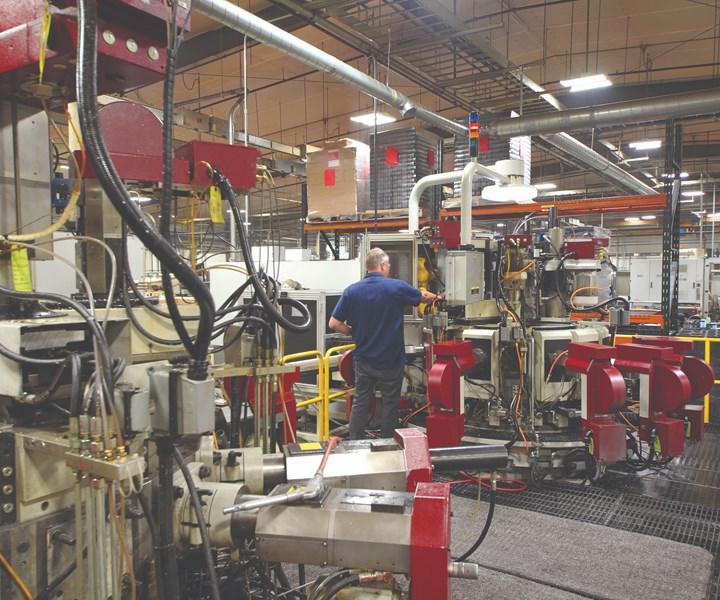
Jeff Prescott, Hydromat technician, runs two Hydromat machines that produce the same part. Both are 16-station machines with vertical tool spindle units and Fanuc robots with hopper-fed blanks.
A Legacy of Machining
ATP has its roots in the Eighmy Corp., which was founded in 1956 by Harry Eighmy, a machinist by trade. The company set down roots in Conneaut, Ohio, machining simple parts for the automotive industry. It ran multi-spindle machines, manufactured its own tools, performed OD and ID grinding and undertook some building of assemblies.
Harry’s son, Gerald B. "Jerry" Eighmy, graduated from Conneaut High School, went to work on the ore boats for U.S. Steel to gather up the money he needed for college. He attended Heidelberg College, getting a degree in chemistry. Shortly after graduating, Jerry started working for his father at the family machining company.
After several decades of operation, the Eighmy Corp. landed a new contract for a seat belt shaft project and purchased three Davenports. However, the parts required heat treating and plating, which at the time were not available in Conneaut. The nearest city for those services was Erie, Pennsylvania. So, in 1984, Jerry founded American Turned Products in Erie. This was a strategic move to reduce supply chain lead time and consolidate supplier partnerships. It also created a separate niche manufacturing plant with all Davenports producing automotive work. The company eventually began adding machines and services as new opportunities arose.
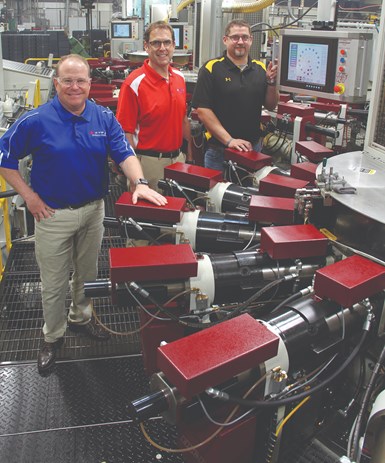
ATP’s co-owner and COO, Harry Eighmy (at left, pictured with Vice President of Client Relations Drew Hoffman and Engineering Manager Nick Adams), along with his brother, co-owner and CEO Scott Eighmy, are working to diversify the company’s work.
During his time in the machining industry, Jerry became highly involved with the National Screw Machine Products Association (NSMPA), now known as the Precision Machined Products Association (PMPA). Jerry served on many committees, as well as the board of directors and as the association president. He also received the Merit Award, the association’s highest honor, for his service to the association and industry. He passed away in 2018 after a lengthy illness, leaving the reigns to his two sons: Scott Eighmy, co-owner and CEO, and Harry Eighmy, co-owner and COO.
Continuous Improvement
Among his employees, Jerry was known for his dedication to continuous improvement principles, and always wanted to have data to back up his research. “He had all these notebooks sorted by machine and by job, stacked in his office,” says ATP’s engineering manager, Nick Adams. “When a point was being debated within the family, he would pull one out from the bottom of a pile, flip to a page and say, ‘Nick, look at this.’”
This emphasis on improvement has led to other changes at the company, including the implementation of lean manufacturing four years ago. These principles, laid out in books such as Paul A. Akers’ Two Second Lean, include education and implementation of 3S lean process improvement (sort, sweep and standardize). According to employees, these changes have helped improve the working relationship between the production workers, engineering and management. “It’s easy to say it’s someone else’s responsibility. We embrace every employee to change what bothers them,” Mr. Adams explains. “Then, we document the problem, before and after, the steps to resolve it, and we show how it was resolved on video.” These improvements are judged to receive monthly awards. Some are small, such as cleaning up a workstation, and others are big ideas, like revising the whole shipping area. “This gives the employee ownership of their daily jobs and authority to make changes so morale goes up,” he adds, “and stops the finger pointing, and we all work better as a team.”
Expanding the Company
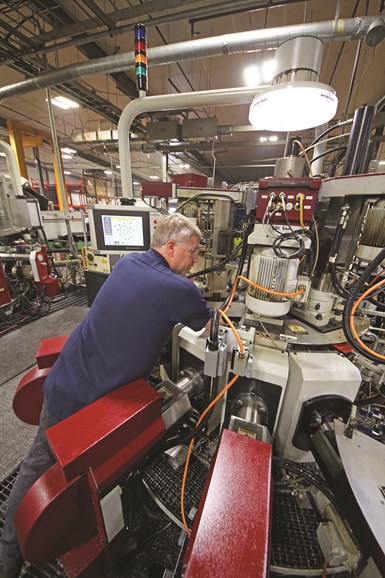
Jeff Prescott changes a tool on a Hydromat Epic R/T machine with multiple vertical units and three-axis CNC flanges on the horizontal tool spindles. ATP got its first Hydromat rotary transfer machine in 1989, and it has since become the company’s go-to method for production turned parts.
ATP’s 50,000-square-foot Erie plant currently houses three Hydromat machines, along with CNC multi-spindle machines, twin-spindle CNCs and single-spindle Swiss CNC lathes that mainly produce automotive and hydraulic parts.
When the time came for the Eighmys to choose between expanding in Erie or building a second facility elsewhere, they chose the latter. The new 45,000-square-foot plant in Fairview, Pennsylvania, 15 miles down the road from Erie, was established in 1998. The Fairview plant, which serves as the company’s headquarters, is primarily a rotary transfer facility with six Hydromat machines in production and one more in the build process at Hydromat’s headquarters in St. Louis, Missouri. It also houses drilling machines, Emag turning centers and Shimada-Kitako lathes, and performs some secondary processes such as CNC grinding, bore finishing and thermal deburring.
Why build in Fairview rather than expand the Erie plant? “We thought it would be easier to manage a facility of 100-150 people rather than one huge plant,” Harry Eighmy says. “We wanted to build a stronger culture within two facilities.” He admits that the two-plant model has downsides; it’s more expensive to run two facilities and requires two of everything. But Harry suggests that although there are extra expenses to operate two facilities, he can also reach certain economies of scale.
In 1990, ATP opened a Davenport plant in El Paso, Texas, for automotive work. “That plant was servicing the maquiladoras in Mexico supplying auto seatbelt and airbags parts,” Harry says. “Our customers had plants in Mexico, so to avoid freight charges from Erie all the way down to Tijuana, Juarez, Reynosa and Monterrey, it made sense to locate a plant in Texas.” In 2006, the El Paso plant was sold to Arrow Manufacturing, now Metal Seal Corp., allowing Harry to come back home to concentrate on their two plants in Pennsylvania.
Disruption Drives Innovation
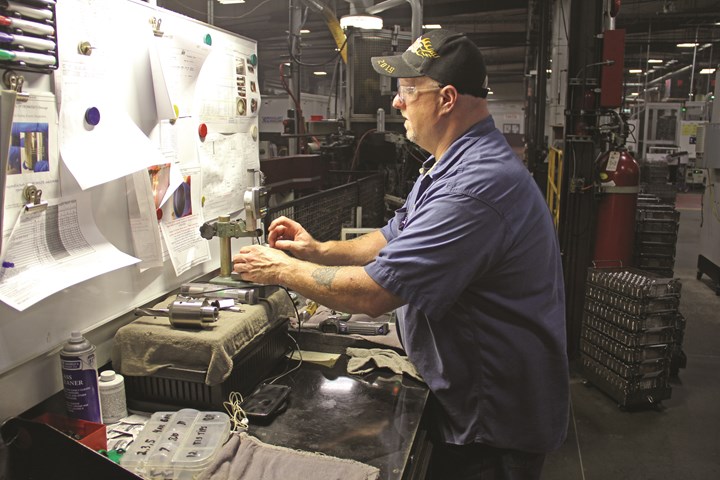
Hydromat technician Ron Mourton checks parts for accuracy. Between 60% and 70% of ATP’s revenue is being produced on Hydromat machines due to their ability to quickly make large quantities of high-quality parts.
ATP was predominantly a Davenport and Acme screw machine house for many years, but its openness to improvement eventually led it to change its view of production machining. “We were doing a large program for GE Home and Laundry Division and were given the opportunity to produce much more of that program,” Harry says. Because of this opportunity, the company was looking for new ways of quickly producing large quantities of high-quality parts. “I knew people who were NSMPA (PMPA) members that had Hydromats and were very happy with them,” he says. The Eighmys were intrigued with the Hydromat machine and the possibility that it could meet the company’s needs.
In 1989 ATP invested in two Hydromat 25-12 legacy-style machines. It quickly found its calculations had been correct—the rotary transfer machines could make high-quality parts faster, yielding larger quantities. For example, ATP had previously been making the specialized seat belt shaft on its Davenports. “We tooled a Hydromat for these seatbelt shafts, and we were able to cut the cycle time in half using the Hydromat versus the Davenport,” Harry says. The company hasn’t looked back, and since then, Hydromats have been the go-to machine for production turned parts.
Two years after the first machines arrived, ATP purchased another Hydromat machine, this time a 45-12. They found that this new addition could make the shaft part even faster and in larger quantities. With free time on the original machines, the company tooled up one of the 25-12s for an automotive airbag part. This turned out to be a lucrative market. “In the 1990s, airbag components became a huge market for safer cars,” Harry explains. “The pubic was demanding a safer vehicle, and the number of airbags per vehicle would only expand. We got into this market early, and it was niche manufacturing, so we had a foothold in the airbag parts business.”
Rotary transfer machines were not necessarily an obvious choice for ATP’s work. According to Mr. Adams, workholding can be a challenge with rotary transfer machines, especially with the types of parts the company produces. “A lot of what we do is uniquely shaped, it’s not nice round bars,” he explains. However, this has become less of an issue over time. “Over the years I’ve seen the workholding from Hydromat improve—the consistency, station to station,” he adds. “In today’s economy, this is what I think sets Hydromat apart.”
According to Mr. Adams, the Hydromats’ advantage are their speed and volume of parts they can produce. These characteristics come into consideration when the shop is deciding whether to run a job on a multi-spindle or a Hydromat. “When ATP has a high volume, and the need for speed, the job ends up steered toward the Hydromat,” he says.
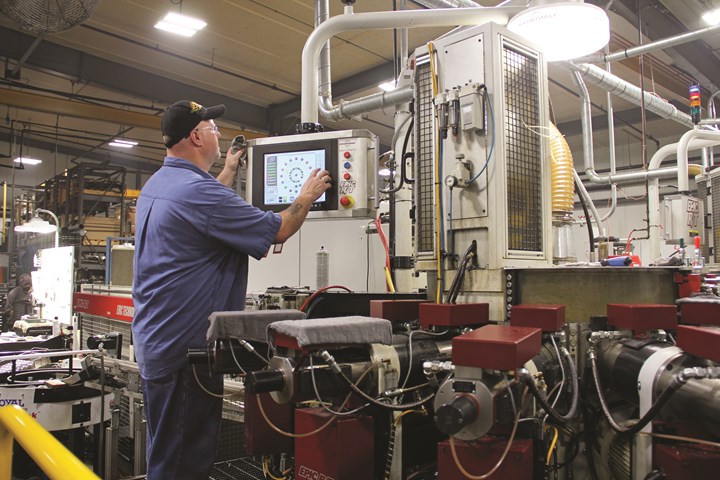
Ron Mourton adjusts the Epic program on one of ATP’s Hydromat R/T 32/45-16 machines. The company works to reduce cycle times by equalizing the cutting times at each station, re-organizing sequences to reduce cycle times by as little as half a second.
Continuous improvement also plays a role in the company’s sustained success with using the Hydromat machines. This means tweaking down cycle times by looking at programming and tooling, and re-organizing the stations. “Once you see how all the stations work together, the goal is to have equal cutting times at each station. ATP is good at equalizing the times. We will re-organize the sequence to get as little as a half a second out,” Mr. Adams says. “When working with Hydromat people, they sometimes think we’re crazy. We always ask for the impossible.”
Culture Change
Currently there are six Hydromats at the Fairview facility, all of them bar-fed machines. Three machines are producing work from automotive and ATP’s other more established work. The other three produce approximately 65,000 parts for newly acquired non-automotive projects.
The introduction of rotary transfer machines dramatically changed the business. “Within five to 10 years of the arrival of our first Hydromats, 60% to 70% of our revenue was being produced with our Hydromats,” Harry explains. “Today, we find that the percentage is still roughly the same. We are predominately a Hydromat shop.” The company’s vice president of client relations, Drew Hoffman, sums up the company’s philosophy with regards to its use of Hydromat machines: “We try to produce complete parts quickly, in a stable process, through a rotary transfer machine.”
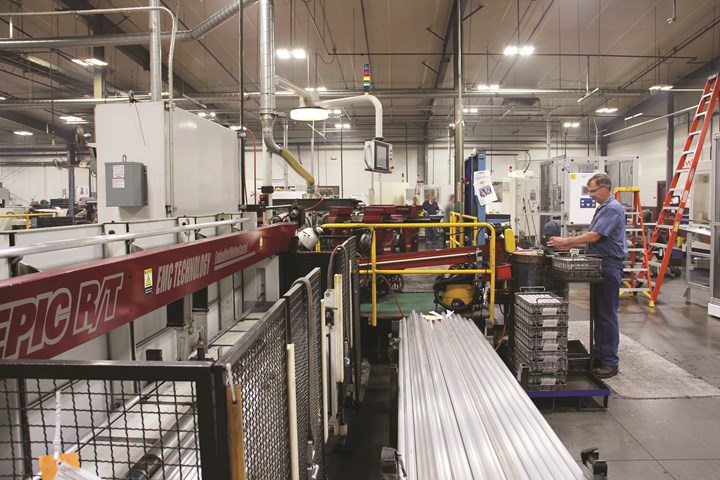
Hydromat technician Alan Sargent checks every aluminum part produced on this bar-fed Hydromat Epic R/T 32/45-16 machine. All six Hydromats at ATP’s Fairview facility are bar fed and produce parts for a range of industries.
According to Harry, the changes are lasting. “It becomes embedded in your culture,” he says. “What I mean by that is when you start running this style of machine, typically you don’t want to bring in another player. We have a very good partnership with Hydromat. We’ve had their machines for 30 years now.”
As Scott and Harry move ATP into the future, they are taking into consideration the changes happening in the automotive industry. The company has experienced disruptions in this industry before—a hydraulic steering part they have run for many years will die soon, making way for electric steering to completely take over. Their big truck diesel engine work has declined in recent years because of better engines with longer lives, a trend that will continue. And the electric vehicle revolution will affect their fossil fuel projects moving forward. “We’ve grown up on automotive so, we don’t necessarily get totally freaked out about the ups and downs of it, and the competitiveness of it,” Harry concludes. “But we certainly look to a weightier range of projects for stability and diversifying our product portfolio.” The brothers are working to diversify the company’s work and add more variety to its part production to help smooth out the rough spots.
Related Content
Edge Technologies Bar Feeder Provides Optimal Stock Support
The FMB Turbo RS 4-45 bar feeder provides reduced vibration, a boost to maximum rpm, better surface finishes and the ability to hold tighter tolerances.
Read MorePrecision Machining Technology Review: August 2024
Production Machining’s August 2024 technology showcase includes some of the latest technology from SW North America, Tsugami, Siemens, Select Manufacturing Technologies, Hurco and ECI Software Solutions — all on display at IMTS 2024.
Read MoreCNC Rotary Transfer Machine Offers AI-Learning, Chipbreaking
Hydromat’s Force CNC Rotary Transfer Machine comes equipped with Force 50/150 tool spindle units, which are FANUC-controlled and offer advanced technology for AI-learning and chipbreaking functions.
Read MoreEdge Technologies Bar Feeder Maximizes RPM Potential
The second-generation Patriot 338 and 551 were designed for faster changeovers, ease of use and safe operation.
Read MoreRead Next
5 Aspects of PMTS I Appreciate
The three-day edition of the 2025 Precision Machining Technology Show kicks off at the start of April. I’ll be there, and here are some reasons why.
Read MoreDo You Have Single Points of Failure?
Plans need to be in place before a catastrophic event occurs.
Read MoreA Tooling Workshop Worth a Visit
Marubeni Citizen-Cincom’s tooling and accessory workshop offers a chance to learn more about ancillary devices that can boost machining efficiency and capability.
Read More















.jpg;maxWidth=300;quality=90)







